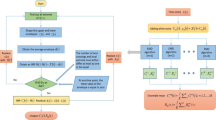Abstract
By combining wavelet analysis with Long Short-Term Memory (LSTM) neural network, this paper proposes a time series prediction model to capture the complex features such as non-linearity, non-stationary and sequence correlation of financial time series. The LSTM is then applied to the prediction of the daily closing price of the Shanghai Composite Index as well as the comparison of its prediction ability with machine learning models such as multi-layer perceptron, support vector machine and K-nearest neighbors. The empirical results show that the LSTM performs a better prediction effect, and it shows excellent effects on the static prediction and dynamic trend prediction of the financial time series, which indicates its applicability and effectiveness to the prediction of financial time series. At the same time, both wavelet decomposition and reconstruction of financial time series can improve the generalization ability of the LSTM prediction model and the prediction accuracy of long-term dynamic trend.










Similar content being viewed by others
References
Taylor, G. W. (2009). Composable, distributed-state models for high-dimensional time series. Toronto: University of Toronto.
Simonyan, K., & Zisserman, A. (2014). Very deep convolutional networks for large-scale image recognition. arXiv:1409.1556.
Sarikaya, R., Hinton, G. E., & Deoras, A. (2014). Application of Deep Belief Networks for natural language understanding. ACM Transactions on Audio Speech and Language Processing, 22(4), 778–784.
Trafalis, T. B., & Ince, H. (2000). Support vector machine for regression and applications to financial forecasting. Neural Networks. In Proceedings of the IEEE-INNS-ENNS international joint conference on IJCNN 2000 (pp. 348–353). IEEE.
Guresen, E., Kayakutlu, G., & Daim, T. U. (2011). Using artificial neural network models in stock market index prediction. Expert Systems with Applications, 38, 10389–10397.
Ahmed, N. K., Atiya, A. F., Gayar, N. E., et al. (2010). An empirical comparison of machine learning models for time series forecasting. Econometric Reviews, 2010, 594–621.
Bengio, Y., & LeCun, Y. (2007). Scaling learning algorithms towards AI. Large-scale kernel machines, 34, 1–41.
Heaton, J. B, Polson, N. G., & Witte, J. H. (2016). Deep learning in finance. arXiv preprint arXiv:1602.06561.
Hinton, G., Deng, L., Yu, D., et al. (2012). Deep neural networks for acoustic modeling in speech recognition: The shared views of four research groups. IEEE Signal Processing Magazine, 29, 82–97.
Taylor, G. W., Fergus, R., Lecun, Y., & Bregler, C. (2010). Convolutional learning of spatio-temporal features. European conference on computer vision (Vol. 6316, pp. 140–153). Springer.
Hsieh, T. J., Hsiao, H. F., & Yeh, W. C. (2011). Forecasting stock markets using wavelet transforms and recurrent neural networks: An integrated system based on artificial bee colony algorithm. Applied soft computing, 11, 2510–2525.
Hochreiter, S., Bengio, Y., Frasconi, P., et al. (2001). Gradient flow in recurrent nets: The difficulty of learning long-term dependencies. In: J. F. Kolen, S. C. Kremer (Eds.), A field guide to dynamical recurrent neural networks (Vol. 28, pp. 237–244). IEEE Press.
Sutskever, I., Vinyals, O., & Le, Q. V. (2014). Sequence to sequence learning with neural networks. In Advances in neural information processing systems (pp. 3104–3112).
Pang, Z. Y., & Liu, L. (2013). Can agricultural product price fluctuation be stabilized by future market: Empirical study based on discrete wavelet transform and GARCH model. Journal of Finance Research, 11, 126–139.
Längkvist, M., Karlsson, L., & Loutfi, A. (2014). A review of unsupervised feature learning and deep learning for time-series modeling. Pattern Recognition Letters, 42, 11–24.
Tesauro, G. (1992). Practical issues in temporal difference learning. Machine Learning, 8, 257–277.
Goodfellow, I., Bengio, Y., & Courville, A. (2016). Deep learning. Cambridge: MIT Press.
Graves, A. (2012). Supervised sequence labelling with recurrent neural networks (pp. 5–13). Berlin: Springer.
Author information
Authors and Affiliations
Corresponding author
Rights and permissions
About this article
Cite this article
Yan, H., Ouyang, H. Financial Time Series Prediction Based on Deep Learning. Wireless Pers Commun 102, 683–700 (2018). https://doi.org/10.1007/s11277-017-5086-2
Published:
Issue Date:
DOI: https://doi.org/10.1007/s11277-017-5086-2




